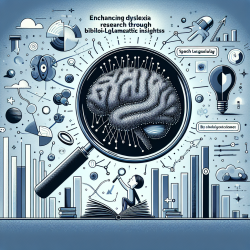Introduction
The field of dyslexia research has experienced significant growth and evolution over the past two decades. The study titled "Dyslexia: A Bibliometric and Visualization Analysis" provides a comprehensive overview of the research landscape, highlighting key trends and emerging areas of interest. This blog aims to distill the findings of this study, offering practitioners actionable insights to enhance their practice and encouraging further research in the field.
Key Findings from the Study
The bibliometric analysis covered 9,166 publications from 2000 to 2021, sourced from the Social Sciences Citation Index (SSCI) and Science Citation Index Expanded (SCI-E). The United States, United Kingdom, and Germany emerged as the most prolific contributors to dyslexia research. Notably, the University of Oxford led in terms of publications and h-index, underscoring its influence in the field.
The study identified "developmental dyslexia," "phonological awareness," and "children" as persistent research topics. Emerging areas include "literacy," "rapid automatized naming (RAN)," "assessment," "intervention," and "functional connectivity." These trends suggest a shift towards more nuanced and multifaceted approaches to understanding and addressing dyslexia.
Implications for Practitioners
For practitioners, these findings highlight the importance of staying abreast of emerging research areas. By integrating insights from the latest studies, practitioners can refine their assessment and intervention strategies, ultimately improving outcomes for children with dyslexia. Here are some specific recommendations:
- Focus on Emerging Topics: Incorporate new research on literacy and rapid automatized naming into your practice. These areas are gaining traction and offer promising avenues for intervention.
- Utilize Advanced Techniques: Consider employing techniques like fMRI and EEG to gain deeper insights into the neurobiological underpinnings of dyslexia.
- Collaborate Across Disciplines: Engage with researchers and practitioners from diverse fields to foster a holistic understanding of dyslexia and develop comprehensive intervention strategies.
Encouraging Further Research
The study underscores the need for continued research, particularly in underexplored areas such as the impact of bilingualism and executive function on dyslexia. Practitioners are encouraged to contribute to this growing body of knowledge by collaborating with researchers and participating in studies.
Moreover, international collaboration is essential to address regional disparities in dyslexia research. By sharing expertise and resources, researchers and practitioners can work towards global solutions that benefit all individuals with dyslexia.
Conclusion
The bibliometric analysis of dyslexia research offers valuable insights for practitioners seeking to enhance their practice and contribute to the field's advancement. By focusing on emerging trends and fostering collaboration, practitioners can play a pivotal role in improving outcomes for children with dyslexia.
To read the original research paper, please follow this link: Dyslexia: A Bibliometric and Visualization Analysis.










